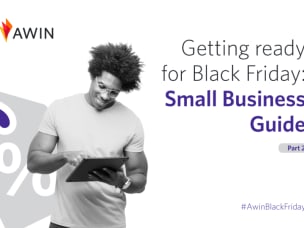Black Friday 101: The evolution of a global retail event
Written by Robert Davinson on 6 minute read
With Black Friday fast-approaching on the horizon, Awin will be discussing a series of themes and subjects relating to the shopping phenomenon.

Given the seemingly all-encompassing success of Black Friday as a global online retail event over the course of the last decade, it’s easy to forget the phenomenon’s origins as a primarily in-store experience. In fact the term itself is one with an interestingly varied history, with competing claims over where it first came from and how it has evolved into its current guise.
What’s agreed upon is that the first general use of the term didn’t relate to shopping at all. Black Friday was instead originally the name given to a scandal on the New York Gold Exchange in 1869 when two rogue speculators surreptitiously cornered the market in the valuable commodity and consequently caused a panic on Wall Street, resulting in a brief downturn in the US economy.
Coincidentally, it was as a boost to the US economy that the timing of the event we now know as Black Friday was deliberately moved to earlier in November. Thanksgiving, the American public holiday inextricably linked with Black Friday, had, since the time of the Founding Fathers, been celebrated by most states on the last Thursday of that month and was swiftly taken up by the population as an opportunity to shop and take advantage of sales in the run-up to Christmas. However, this was later brought forward a week by President Roosevelt in 1941 after pressure from influential store owners who, still suffering from the legacy of the Great Depression, saw an opportunity to increase their sales by shifting it to an earlier date and duly maximising profits from shoppers. Thus the Thanksgiving period was, for many stores, a time in which their balance sheets would go ‘into the black’, representing their first real profits of the year, and leading to one apocryphal explanation of where the term Black Friday actually came from.
Retailers didn’t get everything their own way though. Another of the suggested origins of the term came from store managers’ and employers’ description of the day after Thanksgiving when levels of staff absenteeism would suddenly spike. As one pamphlet from 1951 stated, “’Friday-after-Thanksgiving-itis’ is a disease second only to the bubonic plague in its effects. At least that’s the feeling of those who have to get production out, when Black Friday comes along. The shop may be half empty, but every absentee was sick – and can prove it.”
Anxieties towards the event appear to be a common theme throughout Black Friday’s history. One other suggested source for the term dates back to 1961, in Philadelphia, where the city’s police force and bus drivers would routinely refer to the day after Thanksgiving as ‘Black Friday’ due to the huge volume of traffic and smog provoked by so many shoppers taking to the streets looking for the sales.
The chaos that ensued then is something that contemporary retailers will also certainly recognise. Black Friday sales have for many years been marked by numerous unsavoury incidents in stores caused by the huge discounts on offer and the competition from shoppers attempting to grab these deals before they run out. With the event being successfully replicated outside of the US, other countries have seen similar outbreaks of frenzied behaviour in their stores.
However with Amazon’s successful global promotion of the event as an online experience, Black Friday has swiftly morphed into a hugely effective ecommerce sales tactic and moved the focus of shopping away from the high street and onto screens instead.
As a consequence we’ve seen huge growth for advertisers tracked by Awin on Black Friday, and the wider Cyber Weekend, across the entire global network. Although there have been significant variations in different markets relating to how eagerly these sales dates have been embraced (with consumers in Brazil and the UK being particularly early adopters), 2016 saw the first year at the network where every single Awin market saw both sizable year-on-year revenue growth and traded more on that Friday than the daily average for November. Markets such as Germany and France, which had previously remained resistant to the event’s charms, were for the first time also seen to be increasingly engaged by it.
Black Friday’s growth online has also brought its own set of potential pitfalls for retailers, with some advertiser websites in previous years struggling to support the flash flood of demand that Black Friday suddenly unleashed on servers on the day. But with the event being gradually extended over a longer period thanks to pre-sale discounts and promotions already being launched by retailers prior to the big day last year, the concentration of interest is gradually being distributed over a week-long period instead of just one 24-hour window.
The struggles that retailers have encountered both off and online have resulted in an inevitable backlash from some quarters. In the UK, Walmart-owned supermarket Asda famously pulled back from Black Friday promotions in light of a media storm about fights in their stores for cut-price televisions in 2013. The images were a corporate PR nightmare and Asda hasn’t touched Black Friday since 2015, instead choosing to focus on everyday low pricing. Other brands are making a point of not participating in the melee in order to promote their brands in a different light. In the US, camping brand REI have for the last three years closed their stores and even their website on the day and instead encouraged their staff and customers to get outdoors and away from the consumerist frenzy. Several brands last year put an ethical spin on Black Friday promotions by committing to sharing their profits from the day with selected charities.
There has arguably been an increased strain of cynicism regarding Black Friday from customers too. A piece of research from the authoritative UK consumer rights magazine Which? in 2015 revealed that the deals available on Black Friday weren’t necessarily always the market-leading ones that some retailers implied. Which? monitored over 150 deals both before, during and after Black Friday that year and found that almost half of them were actually cheapest on a day other than Black Friday. Only 8% of the deals published on Black Friday were unique to the event and definitively cheaper than any other day over the extended period that they had reviewed.
Despite this seeming ambivalence around the event, Black Friday’s monumental growth over the last few years has cemented its status as a permanent fixture in marketing calendars around the world. 2016 saw November as the peak month on Awin for the first time, defying the perceived logic of December being the most important trading period. With so much riding on successful performance over the Black Friday period for brands, it is a shopping phenomenon that doesn’t appear to be disappearing any time soon.




